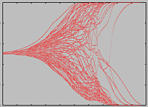
Introduction to the
Mean Field Method
Complex Systems Group
Department of Theoretical Physics
Lund University
Sweden
 |
|
|
Complex Systems Group Department of Theoretical Physics Lund University Sweden |
1. Map the problem onto an energy function, e.g.

where S = {si ; i = 1 ... N} is a set of binary spin variables si = 0 or si = 1, representing the elementary choices involved in minimizing E, while the weightswij encode the costs and constraints.
2. To find configurations with low E, iterate the
mean field (MF) equations,

where T is a fictitious temperature. V = {vi} is a new set of variables, called the mean field variables and represents the thermal average <si>T. Each vi is a continuous variable that lies within [0,1], which allows for a probabilistic interpretation. The above, so called, mean field theory equations are solved iteratively, while lowering T.
The above equations only represent one example. More elaborate encodings have been considered, e.g. based on Potts spins allowing for more general basic decisions elements than simple binary ones. A propagator formalism based on Potts neurons has been developed for handling topological complications in e.g. routing problems.
Back to the Mean Field Solve home page